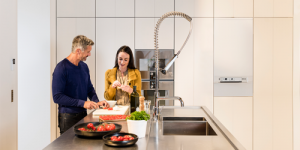Heat pumps – eight important things they don’t tell you
I’m imagining you’ve already worked out how heat pumps work, in that they use fridge technology to collect heat energy from outside, raise the temperature of the collected energy and use it to heat your home. Here is my summary of the information I think you need to know when considering ‘going green’ and replacing your gas or oil boiler with a heat pump, that the government, newspaper articles etc sometimes fail to explain.
1) Heat pumps come in two broad types.
A) those that generate warm air to heat a room or rooms directly… or
B) those that generate warm water to pump around your radiators
Now those that generate warm air seem an excellent idea at first sight but they won’t heat your hot water tank – something easily overlooked in the excitement. If you get a warm air heat pump you’ll need to convert to heating your hot water from gas to (probably) electricity.
2) A heat pump that supplies warm water for radiators will also be able, just about, to supply you with hot water. I say ‘just about’ because the 50 degrees C or so that warm water heat pumps supply is just not quite hot enough to properly guard against your hot water system being a lovely environment for Legionella bacteria to grow. So although the heat pump will supply much of the energy needed to heat your your hot water, you’ll need electric heater elements anyway to give a weekly boost or top up to the stored hot water temperature – to kill off or prevent any potential Legionella bugs from taking hold.
3) Heat pumps either collect their heat energy from the ground, or from the outside air. You’re probably aware of this but you may not realise the latter type has a large air fan which does not run silently. Notice how they emphasise in the marketing how quiet the outside units are – this is because they are not actually quiet. Some are however, much quieter than others 🙂 Edit to add: I happened to encounter one running yesterday (12/7/22) and although running fairly quietly, it was making a deep, low rumble which I would not want to hear in my garden.
The benefits of warm air heat pumps are they cheap to buy and most provide cool air in summer too. Some are modular for fitting by non-refrigeration technicians but generally heat only one or two rooms. Good for summer cooling, poor as a main source of heating for a whole house. One possible exception is when your existing gas heating is the warm air ducted type.
4) The fuel efficiency of hot water-producing heat pumps is poor if they are designed (as most are) to produce water as hot as your existing gas boiler produces. So ‘single stage’ heat pumps (i.e. 99% of those on the market) are limited to about 50 degrees C. This means your radiators will not get so hot, which in turn means you will need bigger radiators when retro-fitting one to replace a gas boiler or the house will not be heated sufficiently in extreme cold weather – just when you need the heating most. To counter this, “two stage” heat pumps are just beginning to appear on the market which heat the water to up to 80C, which makes them a perfect replacement for a gas boiler. If you get a heat pump, I suggest you make sure it is a two stage. Viessmann is the only manufacturer I’ve noticed marketing them so far.
5) Single stage heat pumps are excellent partners with under floor heating systems as underfloor heating uses the low flow temperature that gets the best from a heat pump. Heat pump salesmen will often suggest partnering heat pumps with underfloor heating but I rarely see this advantage mentioned in the media.
6) Underfloor heating relies on heating a large and heavy floor slab, so the response time to you turning up the heating can be very poor. This means it works well if you need your house warm all the time, but not so well if you like to turn it OFF when you go out in the daytime and back ON when you return in the evening. Also might seem unresponsive if you like to turn the heating OFF at night and ON for a short period in the morning before going off to work.
7) Underfloor heating is best not installed in upstairs rooms as it make access to under the floorboards (for occasional but important maintenance) very difficult.

8) It is my view that a hot-water heat pump with it’s low flow temperature is best installed in addition to your existing gas boiler, as a hybrid system. This means you can connect it to your existing radiator system and most of the time, the 50c flow temperature from the heat pump will heat your house perfectly well using the existing radiators (as the weather is not always that cold). When the outside temperature dips below freezing, the gas boiler comes ON to supplement the heat pump output. This method is far more environmentally friendly than using gas to heat your house all the time and seems to me to be a good compromise as it no longer requires you to replace all the radiators with larger. Curiously, I’ve never encountered any examples of this being done. So far I’ve only found one heat pump manufacturer offering this – Daikin. The Daikin “Altherma Hybrid Heat Pump”.

Excellent blog heгe! Alѕo уour site loads ᥙp verу fast!
Wһat web host ɑre yoս using? Can I get yоur affiliate link to
yоur host? I wish mʏ website loaded up as faѕt as үօurs
lol
Thank you kindly, thanks for the feedback! Blog is written with WordPress and Elementor, hosted on my web server at nethosted.co.uk.
Hello! Someone in my Myspace group shared this site with us so I came to give it a look.
I’m definitely loving the information. I’m book-marking and will be tweeting this
to my followers! Superb blog and superb design and style.
Thanks for sharing, air source heat pumps are a popular and effective way to heat and cool a home because they use less energy, are flexible, and are easy to install and keep up. But when choosing an ASHP system for a certain application, it’s important to think about things like the climate, the size of the building, and the budget.